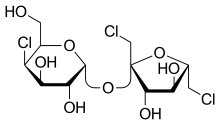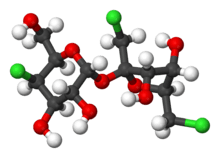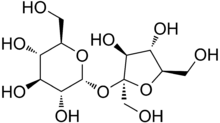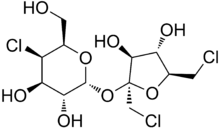Sucralose
Sucralose is an artificial sweetener and sugar substitute. The majority of ingested sucralose is not broken down by the body, so it is noncaloric.[4] In the European Union, it is also known under the E number E955. It is produced by chlorination of sucrose. Sucralose is about 320 to 1,000 times sweeter than sucrose,[5] three times as sweet as both aspartame and acesulfame potassium, and twice as sweet as sodium saccharin. Evidence of benefit is lacking for long-term weight loss with some data supporting weight gain and heart disease risks.[6]
 | |
 | |
| Names | |
|---|---|
| IUPAC name
1,6-Dichloro-1,6-dideoxy-β-D-fructofuranosyl-4-chloro-4-deoxy-α-D-galactopyranoside | |
| Systematic IUPAC name
(2R,3R,4R,5R,6R)-2-[(2R,3S,4S,5S)-2,5-Bis(chloromethyl)-3,4-dihydroxyoxolan-2-yl]oxy-5-chloro-6-(hydroxymethyl)oxane-3,4-diol[2] | |
| Other names
1',4,6'-Trichlorogalactosucrose; Trichlorosucrose; E955; 4,1',6'-Trichloro-4,1',6'-trideoxygalactosucrose; TGS; Splenda[3] | |
| Identifiers | |
3D model (JSmol) |
|
| ChEBI | |
| ChemSpider | |
| ECHA InfoCard | 100.054.484 |
| EC Number |
|
| E number | E955 (glazing agents, ...) |
| KEGG | |
PubChem CID |
|
| UNII | |
CompTox Dashboard (EPA) |
|
InChI
| |
| |
| Properties | |
| C12H19Cl3O8 | |
| Molar mass | 397.64 g/mol |
| Appearance | Off-white to white powder |
| Odor | Odorless |
| Density | 1.69 g/cm3 |
| Melting point | 125 °C (257 °F; 398 K) |
| 283 g/L (20°C) | |
| Acidity (pKa) | 12.52±0.70 |
| Hazards | |
| NFPA 704 (fire diamond) | 
1
1
0 |
Except where otherwise noted, data are given for materials in their standard state (at 25 °C [77 °F], 100 kPa). | |
| Infobox references | |


While sucralose is largely considered shelf-stable and safe for use at elevated temperatures (such as in baked goods), there is some evidence that it begins to break down at temperatures above 119 degrees Celsius.[7][8] The commercial success of sucralose-based products stems from its favorable comparison to other low-calorie sweeteners in terms of taste, stability, and safety.[9] Common brand names of sucralose-based sweeteners are Splenda, Zerocal, Sukrana, SucraPlus, Candys, Cukren, and Nevella. Canderel Yellow also contains sucralose, but the original Canderel and Green Canderel do not.
Uses
Sucralose is used in many food and beverage products because it is a no-calorie sweetener, does not promote dental cavities,[10] is safe for consumption by diabetics and nondiabetics,[11][12] and does not affect insulin levels,[13] although the powdered form of sucralose-based sweetener product Splenda (as most other powdered sucralose products) contains 95% (by volume) bulking agents dextrose and maltodextrin that do affect insulin levels. Sucralose is used as a replacement for, or in combination with, other artificial or natural sweeteners such as aspartame, acesulfame potassium or high-fructose corn syrup. Sucralose is used in products such as candy, breakfast bars and soft drinks. It is also used in canned fruits wherein water and sucralose take the place of much higher calorie corn syrup-based additives. Sucralose mixed with maltodextrin or dextrose (both made from corn) as bulking agents is sold internationally by McNeil Nutritionals under the Splenda brand name. In the United States and Canada, this blend is increasingly found in restaurants, in yellow packets, in contrast to the blue packets commonly used by aspartame and the pink packets used by those containing saccharin sweeteners; in Canada, though, yellow packets are also associated with the SugarTwin brand of cyclamate sweetener.
Cooking
Sucralose is available in a granulated form that allows for same-volume substitution with sugar. This mix of granulated sucralose includes fillers, all of which rapidly dissolve in water. While the granulated sucralose provides apparent volume-for-volume sweetness, the texture in baked products may be noticeably different. Sucralose is not hygroscopic, which can lead to baked goods that are noticeably drier and manifest a less dense texture than those made with sucrose. Unlike sucrose, which melts when baked at high temperatures, sucralose maintains its granular structure when subjected to dry, high heat (e.g., in a 350 °F or 180 °C oven). Furthermore, in its pure state, sucralose begins to decompose at 119 °C or 246 °F.[14] Thus, in some recipes, such as crème brûlée, which require sugar sprinkled on top to partially or fully melt and crystallize, substituting sucralose will not result in the same surface texture, crispness, or crystalline structure.
Health effects
Safety
Sucralose has been accepted as safe by several food safety regulatory bodies worldwide, including the FDA, The Joint FAO/WHO Expert Committee Report on Food Additives, the European Union's Scientific Committee on Food, Health Protection Branch of Health and Welfare Canada, and Food Standards Australia New Zealand. According to the Canadian Diabetes Association, the amount of sucralose that can be consumed over a person's lifetime without any adverse effects is 900 mg per kg of body weight per day.[15][16]
"In determining the safety of sucralose, the FDA reviewed data from more than 110 studies in humans and animals. Many of the studies were designed to identify possible toxic effects, including carcinogenic, reproductive, and neurological effects. No such effects were found, and FDA's approval is based on the finding that sucralose is safe for human consumption." For example, McNeil Nutritional LLC studies submitted as part of its U.S. FDA Food Additive Petition 7A3987 indicated that "in the 2-year rodent bioassays ... there was no evidence of carcinogenic activity for either sucralose or its hydrolysis products ..."[17]
Results from studies in the FDA approval process indicated a lack of risk associated with eating sucralose.[18][19][20][21] When the estimated daily intake (EDI) is compared to the intake at which adverse effects are seen (known as the "highest no-effects limit", or HNEL at 1500 mg/kg BW/day,[22] a large margin of safety exists. The bulk of sucralose ingested is not absorbed by the gastrointestinal tract (gut) and is directly excreted in the feces, while 11–27% of it is absorbed.[5] The amount absorbed from the gut is largely removed from the blood stream by the kidneys and eliminated in the urine, with 20–30% of the absorbed sucralose being metabolized.[5] This means that only between 2–8% of sucralose consumed is metabolized, on average.
Animal studies suggest that there might be a link between sucralose and a reduction in beneficial gut bacteria, with concerns this could result in health issues.[23]
A 2020 study suggests that the consumption of sucralose combined with carbohydrates impairs insulin sensitivity and causing a metabolic impairment which is associated with decreased neural responses to sugar.[24]
Other
The Center for Science in the Public Interest, a consumer advocacy group for food products, downgraded sucralose from "Safe" to "Caution" in June 2013, citing an unpublished study linking sucralose consumption with leukemia risk in rats.[25] The study has been criticized as being poorly executed and reported.[26] The study was published on 29 January 2016 in the peer-reviewed International Journal of Occupational and Environmental Health, and the Center for Science in the Public Interest downgraded sucralose from "Caution" to "Avoid"[27] According to a 2004 study, sucralose has not shown any DNA-damaging properties in DNA repair assays at normal consumption levels, and no evidence of carcinogenicity.[28]
History
Sucralose was discovered in 1976 by scientists from Tate & Lyle, working with researchers Leslie Hough and Shashikant Phadnis at Queen Elizabeth College (now part of King's College London).[29] While researching novel uses of sucrose and its synthetic derivatives, Phadnis was told to "test" a chlorinated sugar compound. Phadnis thought Hough asked him to "taste" it, so he did.[30] He found the compound to be exceptionally sweet.
Tate & Lyle patented the substance in 1976; as of 2008, the only remaining patents concern specific manufacturing processes.[31]
A Duke University animal study funded by the Sugar Association[32] found evidence that doses of Splenda (containing ~1% sucralose and ~99% maltodextrin by weight) between 100 and 1000 mg/kg BW/day, containing sucralose at 1.1 to 11 mg/kg BW/day, fed to rats reduced fecal microflora, increased the pH level in the intestines, contributed to increases in body weight, and increased levels of P-glycoprotein (P-gp).[33] These effects have not been reported in humans.[5] An expert panel, including scientists from Duke University, Rutgers University, New York Medical College, Harvard School of Public Health, and Columbia University reported in Regulatory Toxicology and Pharmacology that the Duke study was "not scientifically rigorous and is deficient in several critical areas that preclude reliable interpretation of the study results".[34]
Sucralose was first approved for use in Canada in 1991. Subsequent approvals came in Australia in 1993, in New Zealand in 1996, in the United States in 1998, and in the European Union in 2004. By 2008, it had been approved in over 80 countries, including Mexico, Brazil, China, India, and Japan.[35] In 2006, the US Food and Drug Administration amended the regulations for foods to include sucralose as a "non-nutritive sweetener" in food.[36] In May 2008, Fusion Nutraceuticals launched a generic product to the market, using Tate & Lyle patents.
In April 2015 PepsiCo announced that it would be moving from aspartame to sucralose for most of its diet drinks in the US,[37] due to sales of Diet Pepsi falling by more than 5% in the US. PepsiCo says its decision is a commercial one - responding to consumer preferences.
In February 2018 PepsiCo went back to using aspartame in Diet Pepsi because of an 8% drop in sales for the previous year.[38][39]
Production
Sucralose is manufactured by the selective chlorination of sucrose in a multistep synthesis, which substitutes three of the hydroxyl groups of sucrose with chlorine atoms. This chlorination is achieved by selective protection of a primary alcohol group, followed by chlorination of the partially acetylated sugar with excess chlorinating agent, and then by removal of the acetyl groups to give the desired sucralose product.[40][41]
Packaging and storage
Pure sucralose is sold in bulk, but not in quantities suitable for individual use, although some highly concentrated sucralose–water blends are available online. These concentrates contain one part sucralose for each two parts water. A quarter teaspoon of concentrate substitutes for one cup of sugar. Pure, dry sucralose undergoes some decomposition at elevated temperatures. In solution or blended with maltodextrin, it is slightly more stable. Most products containing sucralose add fillers and additional sweetener to bring the product to the approximate volume and texture of an equivalent amount of sugar.
Effect on caloric content
Though sucralose contains no calories, products that contain fillers, such as maltodextrin and/or dextrose, add about 2–4 calories per teaspoon or individual packet, depending on the product, the fillers used, brand, and the intended use of the product.[42] The US Food and Drug Administration (FDA) allows for any product containing fewer than five calories per serving to be labeled as "zero calories".[43]
One study suggests that artificial sweeteners may not fully activate the brain's "food reward pathways" as sugar does, stating that, because sweetener does not provide full satisfaction, the user may search for, and then eat, additional high-calorie foods leading to weight gain.[44]
Environmental effects
According to one study, sucralose is digestible by a number of microorganisms and is broken down once released into the environment.[45] However, measurements by the Swedish Environmental Research Institute have shown sewage treatment has little effect on sucralose, which is present in wastewater effluents at levels of several μg/l (ppb).[46] No ecotoxicological effects are known at such levels, but the Swedish Environmental Protection Agency warns a continuous increase in levels may occur if the compound is only slowly degraded in nature. When heated to very high temperatures (over 350 °C or 662 °F) in metal containers, sucralose can produce polychlorinated dibenzo-p-dioxins and other persistent organic pollutants in the resulting smoke.[47]
Sucralose has been detected in natural waters. Studies indicate that this has virtually no impact on the early life development of certain animal species,[48] but the impact on other species remains unknown.
See also
- Erythritol and Xylitol
- Neotame, PureVia, Truvia, Stevia
- Tagatose
- Sugar substitute
References
- Merck Index, 11th Edition, 8854.
- "sucralose 56038-13-2". The Good Scents Company Information System. Retrieved 30 January 2014.
- Anonymous. Scifinder – Substance Detail for 56038-13-2, 30 October 2010.
- "Gestational Diabetes and Low-Calorie Sweeteners: Answers to Common Questions" (PDF). Food Insight. Retrieved 15 May 2015.
- Michael A. Friedman, Lead Deputy Commissioner for the FDA, Food Additives Permitted for Direct Addition to Food for Human Consumption; Sucralose Federal Register: 21 CFR Part 172, Docket No. 87F-0086, 3 April 1998
- Azad, Meghan B.; Abou-Setta, Ahmed M.; Chauhan, Bhupendrasinh F.; Rabbani, Rasheda; Lys, Justin; Copstein, Leslie; Mann, Amrinder; Jeyaraman, Maya M.; Reid, Ashleigh E.; Fiander, Michelle; MacKay, Dylan S.; McGavock, Jon; Wicklow, Brandy; Zarychanski, Ryan (16 July 2017). "Nonnutritive sweeteners and cardiometabolic health: a systematic review and meta-analysis of randomized controlled trials and prospective cohort studies". Canadian Medical Association Journal. 189 (28): E929–39. doi:10.1503/cmaj.161390. PMC 5515645. PMID 28716847.
- "Thermal stability and thermal decomposition of sucralose". ResearchGate. Retrieved 11 August 2019.
- de Oliveira, Diogo N.; de Menezes, Maico; Catharino, Rodrigo R. (15 April 2015). "Thermal degradation of sucralose: a combination of analytical methods to determine stability and chlorinated byproducts". Scientific Reports. 5: 9598. doi:10.1038/srep09598. ISSN 2045-2322. PMC 4397539. PMID 25873245.
- A Report on Sucralose from the Food Sanitation Council, The Japan Food Chemical Research Foundation
- Food and Drug Administration (2006). "Food labeling: health claims; dietary noncariogenic carbohydrate sweeteners and dental caries". Federal Register. 71 (60): 15559–64. PMID 16572525.
- Grotz, VL; Henry, RR; McGill, JB; Prince, MJ; Shamoon, H; Trout, JR; Pi-Sunyer, FX (2003). "Lack of effect of sucralose on glucose homeostasis in subjects with type 2 diabetes". Journal of the American Dietetic Association. 103 (12): 1607–12. doi:10.1016/j.jada.2003.09.021. PMID 14647086.
- FAP 7A3987, 16 August 1996. pp. 1–357. A 12-week study of the effect of sucralose on glucose homeostasis and HbA1c in normal healthy volunteers, Center for Food Safety and Applied Nutrition, U.S. FDA
- Ford, HE; Peters, V; Martin, NM; Sleeth, ML; Ghatei, MA; Frost, GS; Bloom, SR (April 2011). "Effects of oral ingestion of sucralose on gut hormone response and appetite in healthy normal-weight subjects" (PDF). European Journal of Clinical Nutrition. 65 (4): 508–13. doi:10.1038/ejcn.2010.291. PMID 21245879.
- Bannach, Gilbert; Rafael R. Almeida; Luis. G. Lacerda; Egon Schnitzler; Massao Ionashiro (December 2009). "Thermal stability and thermal decomposition of sucralose" (PDF). Sci. Rep. 34 (4): 21–26. doi:10.1590/S0100-46702009000400002.
- "Canadian Diabetes Association 2008 Clinical Practice Guidelines for the Prevention and Management of Diabetes in Canada" (PDF). Canadian Journal of Diabetes. 32 (Supplement 1): S41. September 2008.
- Goldsmith LA (2000). "Acute and subchronic toxicity of sucralose". Food Chem. Toxicol. 38 Suppl 2: S53–69. doi:10.1016/s0278-6915(00)00028-4. PMID 10882818.
- "Sucralose - FDA Final Rule - Food Additives Permitted for Direct Addition to Food for Human Consumption" (PDF). United States: Food and Drug Administration. Archived from the original (PDF) on 18 October 2012. Retrieved 17 July 2011.
- Frank, Genevieve. "Sucralose: An Overview". Penn State University.
- Rodero, A. B.; Rodero, L. S.; Azoubel, R. (2009). "Toxicity of sucralose in humans: a review" (PDF). Int. J. Morphol. 27 (1): 239–44. doi:10.4067/s0717-95022009000100040.
- Grotz VL; Munro IC (2009). "An overview of the safety of sucralose". Regul. Toxicol. Pharmacol. 55 (1): 1–5. doi:10.1016/j.yrtph.2009.05.011. PMID 19464334.
- Grice HC; Goldsmith LA (2000). "Sucralose--an overview of the toxicity data". Food Chem. Toxicol. 38 (Suppl 2): S1–6. doi:10.1016/S0278-6915(00)00023-5. PMID 10882813.
- Baird, I. M.; Shephard, N. W.; Merritt, R. J.; Hildick-Smith, G. (2000). "Repeated dose study of sucralose tolerance in human subjects". Food and Chemical Toxicology. 38 (Supplement 2): S123–29. doi:10.1016/S0278-6915(00)00035-1. PMID 10882825.
- Schiffman, SS; Rother, KI (2013). "Sucralose, a synthetic organochlorine sweetener: overview of biological issues". Journal of Toxicology and Environmental Health, Part B. 16 (7): 399–451. doi:10.1080/10937404.2013.842523. PMC 3856475. PMID 24219506.
- Small, Dalenberg. "Short-Term Consumption of Sucralose with, but Not without, Carbohydrate Impairs Neural and Metabolic Sensitivity to Sugar in Humans". Cell.
- "CSPI Downgrades Splenda From "Safe" to "Caution"" (PDF). Center for Science in the Public Interest. 12 June 2013.
- "Controversial Italian Scientist Says Splenda Causes Cancer" (PDF). Forbes. April 2012.
- "CSPI Downgrades Sucralose From Caution To Avoid". CSPI. February 2016.
- Weihrauch MR, Diehl V (2004). "Artificial sweeteners—do they bear a carcinogenic risk?". Ann. Oncol. 15 (10): 1460–5. doi:10.1093/annonc/mdh256. PMID 15367404.CS1 maint: uses authors parameter (link)
- "Frequently Asked Questions About Sucralose". Sucralose. Retrieved 20 September 2018.
- Gratzer, Walter (28 November 2002). "5. Light on sweetness: the discovery of aspartame". Eurekas and Euphorias: The Oxford Book of Scientific Anecdotes. Oxford University Press. pp. 32–. Bibcode:2002eueu.book.....G. ISBN 978-0-19-280403-7. Retrieved 1 August 2012.
- "Tate & Lyle loses sucralose patent case". ap-foodtechnology.com.
- Browning, Lynnley (2 September 2008). "New Salvo in Splenda Skirmish". The New York Times. Retrieved 24 May 2010.
- Abou-Donia, MB; El-Masry, EM; Abdel-Rahman, AA; McLendon, RE; Schiffman, SS (2008). "Splenda alters gut microflora and increases intestinal p-glycoprotein and cytochrome p-450 in male rats". J. Toxicol. Environ. Health A. 71 (21): 1415–29. doi:10.1080/15287390802328630. PMID 18800291.
- Daniells, Stephen (2 September 2009). "Sucralose safety 'scientifically sound': Expert panel".
- "SPLENDA® Brand Sweetener FAQ: Safety & Product Information: What research has been conducted to confirm the safety of SPLENDA®". McNeil Nutritionals, LLC. Retrieved 29 August 2015.
- Turner, James (3 April 2006). "FDA amends regulations that include sucralose as a non-nutritive sweetener in food" (PDF). FDA Consumer. Retrieved 7 September 2007.
- Roberts, Michelle (27 April 2015). "Pepsi to ditch artificial sweetener". BBC News.
- "Diet Pepsi Revamp Leaves 'Aspartame Free' Gamble Behind". Beverage Digest. 16 February 2018.
- Schultz, E. J. (16 February 2018). "Reversing Course, Diet Pepsi Goes All-In on Aspartame". Advertising Age.
- Bert Fraser-Reid, 2012, "From Sugar to Splenda: A Personal and Scientific Journey of a Carbohydrate Chemist and Expert Witness," Berlin:Springer, pp. 199-210, and passim, see , accessed 2 November 2014.
- U.S. Patent 5,498,709
- Filipic, Martha Chow Line: Sucralose sweet for calorie-counters (for 10/3/04) Ohio State Human Nutrition article on sucralose
- "CFR – Code of Federal Regulations Title 21". U.S. Food and Drug Administration. 1 April 2011. Retrieved 11 March 2012.
- Yang, Q (2010). "Gain weight by "going diet?" Artificial sweeteners and the neurobiology of sugar cravings: Neuroscience 2010". The Yale Journal of Biology and Medicine. 83 (2): 101–8. PMC 2892765. PMID 20589192.
- Labare, Michael P; Alexander, Martin (1993). "Biodegradation of sucralose in samples of natural environments". Environmental Toxicology and Chemistry. 12 (5): 797–804. doi:10.1897/1552-8618(1993)12[797:BOSACC]2.0.CO;2.
- Measurements of Sucralose in the Swedish Screening Program 2007, Part I; Sucralose in surface waters and STP samples
- Dong, Shujun; Liu, Guorui; Hu, Jicheng; Zheng, Minghui (15 October 2013). "Polychlorinated dibenzo-p-dioxins and dibenzofurans formed from sucralose at high temperatures". Scientific Reports. 3: 2946. Bibcode:2013NatSR...3E2946D. doi:10.1038/srep02946. PMC 3796739. PMID 24126490.
- Stoddard KI, Huggett DB (2014). "Early Life Stage (ELS) Toxicity of Sucralose to Fathead Minnows, Pimephales promelas". Bull. Environ. Contam. Toxicol. 93 (4): 383–87. doi:10.1007/s00128-014-1348-9. PMID 25120258.
Further reading
- An extensive account of the history of the discovery of sucralose, and its patent issues, by a professor of chemistry: Fraser-Reid, Bert (2012). From Sugar to Splenda: A Personal and Scientific Journey of a Carbohydrate Chemist and Expert Witness. Springer. ISBN 978-3642227806.
- A research study on the bacteriostatic effects on six isolates introduced to sucralose and sucralose as a potential wastewater contaminant: Omran, Arthur; Ahearn, Gregory; Bowers, Doria; Swenson, Janice; Coughlin, Charles (2013). "Metabolic Effects of Sucralose on Environmental Bacteria". Journal of Toxicology. 2013: 1–6. doi:10.1155/2013/372986. PMC 3866777. PMID 24368913.CS1 maint: uses authors parameter (link)
External links
| Wikimedia Commons has media related to Sucralose. |
- U.S. FDA Code of Federal Regulations Database, Sucralose Section, As Amended 12 August 1999
- Material Safety Data Sheet for Sucralose
- Ferrer, Imma; Thurman, E. M. (2010). "Analysis of sucralose and other sweeteners in water and beverage samples by liquid chromatography/time-of-flight mass spectrometry". J. Chromatogr. A. 1217 (25): 4127–34. doi:10.1016/j.chroma.2010.02.020. PMID 20304407.